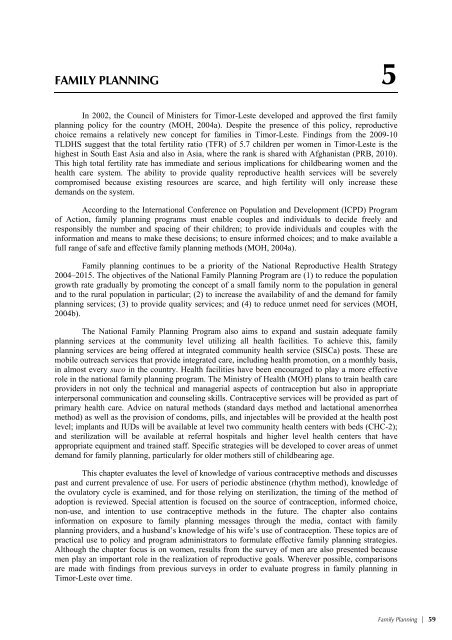Demographic and Health Survey 2009-10 - Timor-Leste Ministry of ...
Demographic and Health Survey 2009-10 - Timor-Leste Ministry of ...
Demographic and Health Survey 2009-10 - Timor-Leste Ministry of ...
Create successful ePaper yourself
Turn your PDF publications into a flip-book with our unique Google optimized e-Paper software.
FAMILY PLANNING 5<br />
In 2002, the Council <strong>of</strong> Ministers for <strong>Timor</strong>-<strong>Leste</strong> developed <strong>and</strong> approved the first family<br />
planning policy for the country (MOH, 2004a). Despite the presence <strong>of</strong> this policy, reproductive<br />
choice remains a relatively new concept for families in <strong>Timor</strong>-<strong>Leste</strong>. Findings from the <strong>2009</strong>-<strong>10</strong><br />
TLDHS suggest that the total fertility ratio (TFR) <strong>of</strong> 5.7 children per women in <strong>Timor</strong>-<strong>Leste</strong> is the<br />
highest in South East Asia <strong>and</strong> also in Asia, where the rank is shared with Afghanistan (PRB, 20<strong>10</strong>).<br />
This high total fertility rate has immediate <strong>and</strong> serious implications for childbearing women <strong>and</strong> the<br />
health care system. The ability to provide quality reproductive health services will be severely<br />
compromised because existing resources are scarce, <strong>and</strong> high fertility will only increase these<br />
dem<strong>and</strong>s on the system.<br />
According to the International Conference on Population <strong>and</strong> Development (ICPD) Program<br />
<strong>of</strong> Action, family planning programs must enable couples <strong>and</strong> individuals to decide freely <strong>and</strong><br />
responsibly the number <strong>and</strong> spacing <strong>of</strong> their children; to provide individuals <strong>and</strong> couples with the<br />
information <strong>and</strong> means to make these decisions; to ensure informed choices; <strong>and</strong> to make available a<br />
full range <strong>of</strong> safe <strong>and</strong> effective family planning methods (MOH, 2004a).<br />
Family planning continues to be a priority <strong>of</strong> the National Reproductive <strong>Health</strong> Strategy<br />
2004–2015. The objectives <strong>of</strong> the National Family Planning Program are (1) to reduce the population<br />
growth rate gradually by promoting the concept <strong>of</strong> a small family norm to the population in general<br />
<strong>and</strong> to the rural population in particular; (2) to increase the availability <strong>of</strong> <strong>and</strong> the dem<strong>and</strong> for family<br />
planning services; (3) to provide quality services; <strong>and</strong> (4) to reduce unmet need for services (MOH,<br />
2004b).<br />
The National Family Planning Program also aims to exp<strong>and</strong> <strong>and</strong> sustain adequate family<br />
planning services at the community level utilizing all health facilities. To achieve this, family<br />
planning services are being <strong>of</strong>fered at integrated community health service (SISCa) posts. These are<br />
mobile outreach services that provide integrated care, including health promotion, on a monthly basis,<br />
in almost every suco in the country. <strong>Health</strong> facilities have been encouraged to play a more effective<br />
role in the national family planning program. The <strong>Ministry</strong> <strong>of</strong> <strong>Health</strong> (MOH) plans to train health care<br />
providers in not only the technical <strong>and</strong> managerial aspects <strong>of</strong> contraception but also in appropriate<br />
interpersonal communication <strong>and</strong> counseling skills. Contraceptive services will be provided as part <strong>of</strong><br />
primary health care. Advice on natural methods (st<strong>and</strong>ard days method <strong>and</strong> lactational amenorrhea<br />
method) as well as the provision <strong>of</strong> condoms, pills, <strong>and</strong> injectables will be provided at the health post<br />
level; implants <strong>and</strong> IUDs will be available at level two community health centers with beds (CHC-2);<br />
<strong>and</strong> sterilization will be available at referral hospitals <strong>and</strong> higher level health centers that have<br />
appropriate equipment <strong>and</strong> trained staff. Specific strategies will be developed to cover areas <strong>of</strong> unmet<br />
dem<strong>and</strong> for family planning, particularly for older mothers still <strong>of</strong> childbearing age.<br />
This chapter evaluates the level <strong>of</strong> knowledge <strong>of</strong> various contraceptive methods <strong>and</strong> discusses<br />
past <strong>and</strong> current prevalence <strong>of</strong> use. For users <strong>of</strong> periodic abstinence (rhythm method), knowledge <strong>of</strong><br />
the ovulatory cycle is examined, <strong>and</strong> for those relying on sterilization, the timing <strong>of</strong> the method <strong>of</strong><br />
adoption is reviewed. Special attention is focused on the source <strong>of</strong> contraception, informed choice,<br />
non-use, <strong>and</strong> intention to use contraceptive methods in the future. The chapter also contains<br />
information on exposure to family planning messages through the media, contact with family<br />
planning providers, <strong>and</strong> a husb<strong>and</strong>’s knowledge <strong>of</strong> his wife’s use <strong>of</strong> contraception. These topics are <strong>of</strong><br />
practical use to policy <strong>and</strong> program administrators to formulate effective family planning strategies.<br />
Although the chapter focus is on women, results from the survey <strong>of</strong> men are also presented because<br />
men play an important role in the realization <strong>of</strong> reproductive goals. Wherever possible, comparisons<br />
are made with findings from previous surveys in order to evaluate progress in family planning in<br />
<strong>Timor</strong>-<strong>Leste</strong> over time.<br />
Family Planning | 59
















